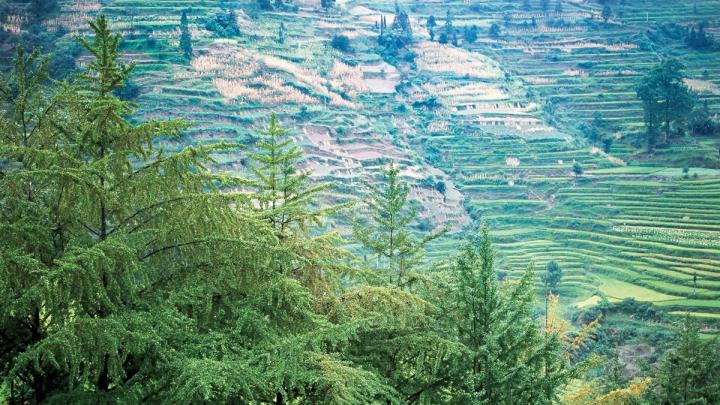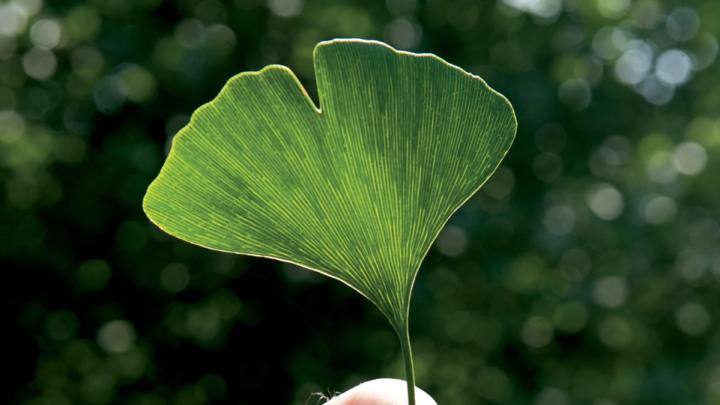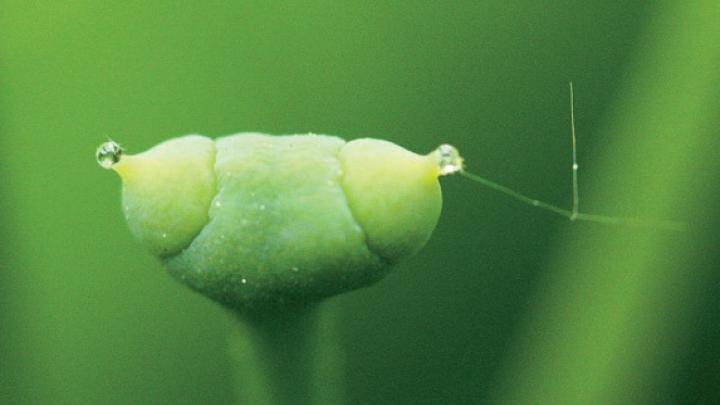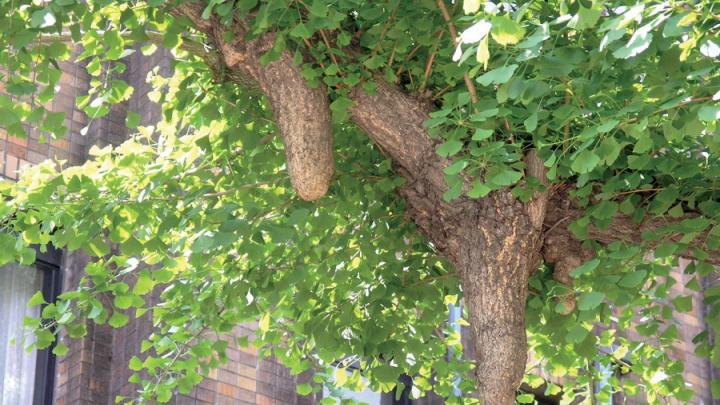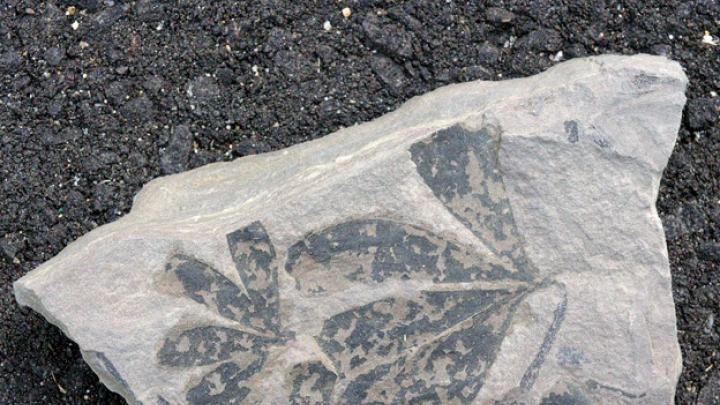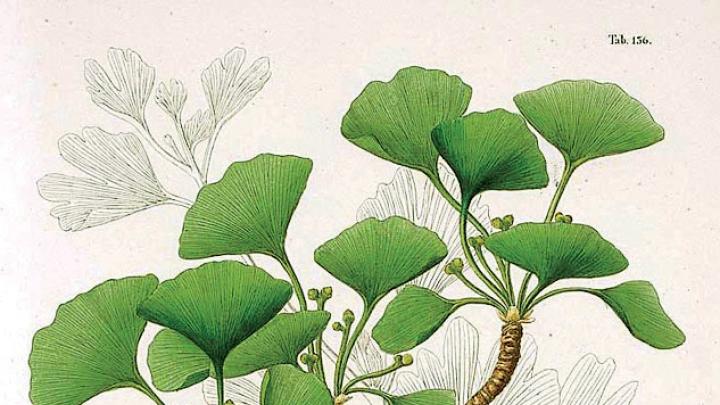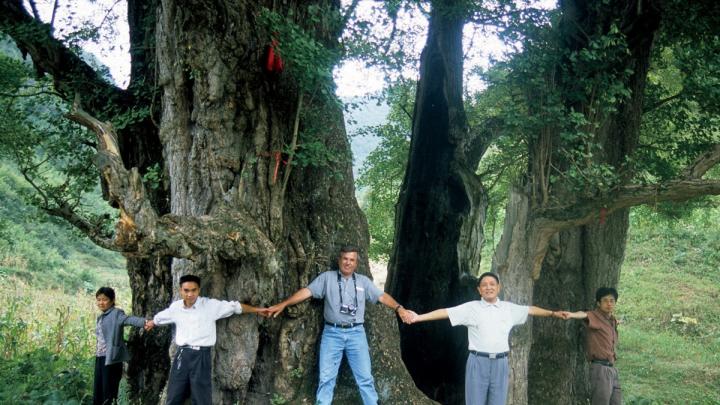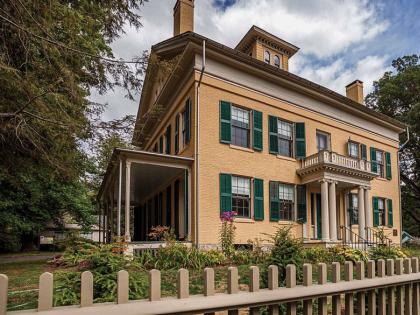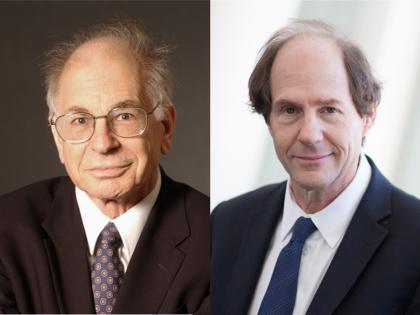In early october 1989, Peter Del Tredici of Harvard’s Arnold Arboretum was high on the slopes of Tian Mu Mountain Nature Reserve in western Zhejiang Province, counting ginkgo trees with two Chinese collaborators. For 1,500 years, visiting pilgrims had journeyed to this sacred mountain, where Buddhist monks in the late thirteenth century built the famous Kaishan Temple, the largest of many picturesque shrines scattered about the steep hillsides. In the cool fall weather, wrote Del Tredici, then 43, “we walked all the paths and trails in the reserve and measured and mapped the locations of all the ginkgos that we could locate. Ginkgo leaves were turning yellow, making it easy to locate the trees even at some distance.” All told, they found “167 spontaneously growing Ginkgos.” In the world of trees and botany, the finding of wild ginkgos was big news.
The Ginkgo biloba is one of the wonders of the natural world, a “living fossil” whose arboreal ancestors date back to the Jurassic period. “How or why the ginkgo managed to survive when all of its relatives went extinct is an unsolved botanical mystery,” wrote Del Tredici in Horticulture back in 1983—a mystery he would spend two decades helping to partially unravel. The term “living fossil” was coined by Darwin; in Del Tredici’s words, it refers to a living species “with a long evolutionary history and no close living relatives.” An average plant species may have an evolutionary run of a few million years; Ginkgo biloba has been around, with minimal changes, for about 56 million years.
Sharing the earth with dinosaurs, the ginkgos—often a dominant forest species—grew across the Northern Hemisphere along disturbed stream beds and levees. Then, about seven million years ago, the glaciers pushed out the last of the ginkgos in America; two million years ago, the ice pushed out the last of the ginkgos in Europe. Ultimately, Ginkgo biloba survived only in Asia.
Today, the dinosaurs are long since extinct but the ginkgo, thanks to gardeners and urban foresters, has recolonized the very continents where it once thrived, a ubiquitous, super-hardy city-tree species. Also known as the maidenhair tree, it has long been admired for its distinctive, elegant, fan-shaped leaves, and valued for its delicate nuts—but it is infamous, too, for the foul odor of its fruits, whose “fleshy outer covering [the sarcotesta],” noted Arboretum founder Charles Sprague Sargent in 1877, “exhales an extremely disagreeable smell of rancid butter.” (Others describe it as “vomitous.”) Having long outlived the pests and diseases that may have afflicted it, a ginkgo is young at 100, when most other street trees have long since died of old age or disease. This is an amazing botanical conquest and comeback.
In the late nineteenth century, when Western plant explorers descended upon China and Japan seeking botanical treasure, they were amazed at the size and antiquity of certain ginkgos: 100-foot-tall trees with 50-foot girths that were 1,000 or even 2,000 years old, growing around temples and monasteries. One of those plant men was collector Ernest H. “Chinese” Wilson, whose two China expeditions from 1907 to 1911 amassed 65,000 botanical specimens for Harvard’s arboretum. (Artfully laid out on 265 acres in Jamaica Plain, the arboretum was conceived in 1872 as both a Boston public park and a Harvard research institution, where the “Living Collections” would serve as a “Tree Museum” and a research resource. Harvard purchased the land for the arboretum and then donated it to the city of Boston, which constructed the park and leased it back to the University for a thousand years for $1 a year.)
In 1930, not long before Wilson’s death in a car accident in Worcester, this legendary botanical explorer declared in no uncertain terms that the ginkgo “no longer exists [in Asia] in a wild state, and there is no authentic record of its ever having been seen growing spontaneously. Travelers of repute of many nationalities have searched for it far and wide in the Orient but none has succeeded in solving the secret of its home….In Japan, Korea, southern Manchuria, and in China proper it is known as a planted tree only, and usually in association with religious buildings, palaces, tombs, and old historic or geomantic sites….What caused its disappearance [in the wild] we shall never know.” Such was Wilson’s clout, reported Del Tredici, that this romantic story of venerable monks preserving this ancient tree “had become dogma.” In 1967 a professor wrote in Science, “It is doubtful, however, whether a natural stand of ginkgo trees is to be found anywhere in the world today.”
Wandering the woods of Tian Mu more than two decades later, Del Tredici, who is today a senior research scientist at the arboretum, believed he had found the elusive and long-sought wild ginkgos. Locating them could help address some of the tree’s evolutionary mysteries. For Del Tredici, the ginkgo offered botanists “a unique window on the past—sort of like having a living dinosaur available to study.” He hoped to learn how this amazing species had managed to survive in the wild since the dinosaurs. How had some ginkgos lived more than a thousand years when few tree species live even hundreds of years? What served as the dispersal agent for its seeds? And what evolutionary purpose caused their fruits to smell so god-awful?
The 600 species of trees that grow in temperate North America today fall into three divisions: Pinophyta, which includes all the hundreds of conifers, or cone-bearing seed plants; Magnoliophyta, including the hundreds of broadleaf trees, whose reproduction is tied to their flowers and fruits; and Ginkgophyta, which includes only one tree, Ginkgo biloba, with a reproductive system unlike that of other trees. Although the fact that ginkgo trees are either male or female is not unusual in the tree world, this gender distinction is considered evolutionarily primitive.
“The order to which the tree belongs, the Ginkgoales,” wrote Del Tredici in Arnoldia, “can be traced back to the Permian era, almost 250 million years ago,” thanks to the study of many ginkgo fossils found in the Northern Hemisphere. “The genus Ginkgo made its first appearance in the middle Jurassic period, 170 million years ago….At least four different species of Ginkgo coexisted with the dinosaurs during the Lower Cretaceous.” One of the four species, G. adiantoides, possessed leaves and female ovules that are similar to, but smaller than, those of G. biloba, the species that exists today. In short, the ginkgo has probably existed on earth longer than any other tree now living.
The first ginkgo to grow in Europe after the Ice Age was raised from seed brought from Japan around 1730 by German physician-botanist Engelbert Kaempfer. Planted at the Botanic Garden in Utrecht, Holland, that ginkgo (which thrives to this day) was viewed simply as another rare and exotic tree from the land of the shoguns. In the ensuing decades, botanists at Kew Gardens in England, the Botanic Garden in Montpelier, France, and elsewhere on the continent planted their own rare specimens. In 1784, Philadelphian William Hamilton was delighted to be the first in his young nation to have one of these “Oriental” trees on his Woodlands estate. Naturalist William Bartram planted one nearby in his garden. Today it is the oldest ginkgo in America. But until 1896, botanists, who knew ginkgos were ancient thanks to fossilized specimens, had no idea just how old Ginkgo biloba was.
That year, on September 9 in Tokyo, Japanese botanist Sakugoro Hirase peered through his microscope at the inside of a female ginkgo tree’s ovule. The previous spring, a male ginkgo’s pollen had wafted on the wind toward a female ginkgo with many dangling pairs of round ovules. On the tip of an ovule, a secreted drop of gooey fluid captured and absorbed the pollen into an interior pollen chamber. The pollen had grown all through the summer and, as Hirase was astounded to observe, it had become a multiflagellated ginkgo sperm (three times larger than human sperm) that was swimming to fertilize a waiting egg cell.
“This was really momentous,” according to Del Tredici. “The discovery of motile sperm captured people’s attention. From the scientific point of view, motile sperm was considered to be a trait associated with evolutionarily primitive, non-seed plants such as mosses and ferns. And yet here was the ginkgo tree—clearly a seed-producing plant—with its motile sperm that linked non-seed plants to the more evolutionarily advanced conifers and angiosperms with pollen tubes and non-motile sperm. People realized, ‘My God! Ginkgo is a missing link—a living fossil.’ ”
The ginkgo tree has the same archaic reproductive system as the cycads, which predate the dinosaurs. It takes about 133 days for the ginkgo pollen to develop into sperm that then flails its way to the egg and creates a growing embryo. Soon thereafter, in the fall, the fleshy seeds, containing a hard-shelled nut with a tiny embryo, drop to the ground. Not until the next spring will the seeds germinate. Ginkgo fossils showed that the tree’s reproductive system has been largely unchanged since the Cretaceous. This “direct link with ancient fossil plants,” from before the age of flowering plants, wrote Del Tredici, “gives the modern Ginkgo biloba a pedigree unmatched by any living tree.” Thus Ginkgo was catapulted to a new status of “living fossil”—but a fossil, it was believed, that had survived only through human cultivation, whether for its delicious nuts or its status as a revered “elder.”
When Del Tredici began stalking the wild ginkgo in China in 1989, he was resuming a plant-hunting tradition at the Arnold Arboretum that had ended when “the Bamboo Curtain came down in 1949.” He worked with Nanjing Botanical Garden director Yang Guang and Chinese forester Ling Hsieh. What was hard to ignore as the three men located and measured the golden-leaved ginkgos on Tian Mu Mountain was the paucity of young trees. “Clearly,” wrote Del Tredici, “the Ginkgo population was not actively reproducing from seed under the shady, mature forest conditions that currently prevail on the mountain.” Then they learned that the local populace (and the red-bellied squirrels) had already played “an important factor limiting seedling establishment”: they had collected most of the foul-smelling fruits for the seed-kernel inside. In fact, many Chinese farmers had established ginkgo orchards in order to harvest these nuts as a cash crop.
But Del Tredici did observe something exciting and unfamiliar on Tian Mu: “[M]ost of the larger Ginkgos were reproducing vigorously from suckers arising near the base of their trunks….Wherever the base of the trunk of a large Ginkgo came into direct contact with a large rock or where its base was exposed by erosion, these structures developed…When these growths reach friable soil, they produce lateral roots, develop vigorous growing shoots, and continue their downward growth.” Where conditions were disturbed or tough, ginkgos responded by sending up new shoots from their roots that began growing into new trees. As a result, many old ginkgos have multiple trunks.
Very old ginkgos had long been observed to grow “air roots” from their upper branches. These were known in Japan as chichi (nipples, or breasts), harking back to a Japanese folk tale about an ancient ginkgo in Sendai that grew over the tomb of an emperor’s wet nurse, who vowed to Buddha that mothers who failed to lactate could pray there and would then be able to nurse their babies. Del Tredici was not seeing the aerial “breasts,” but basal chichi (lignotubers). “They had never before been described in the English literature,” he says. This helped explain how ginkgos could live so many millennia. Not only had they outlived pests and diseases, but they resprouted when under stress.
“Going to China was really a leap of faith, but that’s what science is all about,” said Del Tredici during a recent conversation in his arboretum office—an airy space of exposed brick walls, large windows overlooking many trees, two desks and two computers, his collection of old herbal medicine bottles, drawings and photos of ginkgos, and bookcases crammed with titles like Design in Nature: Learning from Trees. “When I came back I did experiments on reproduction and morphology in the lab and the greenhouse on this survival mechanism that ginkgo had evolved.” In the greenhouse, he was able to demonstrate that “basal chichi develop from suppressed cotyledonary [embryonic leaf] buds.
“To my great relief, on that first trip to China,” he said, “I found and explained the ability of ginkgos to survive so long. Even though their sexual reproduction system is archaic and doesn’t work all that well, the tree has this ability to resprout. I call it ecological immortality. Ginkgo became my case study for integrating ecological knowledge with botanical knowledge with horticultural knowledge. I was able to bring all these pieces together into a unified picture.” He was well launched on helping to unravel some of Ginkgo’s evolutionary mystery. The basal chichi helped explain the persistence of the species into the modern era and the extraordinary age of individual trees. Del Tredici’s discovery established a mechanism that has allowed this “living fossil” to survive in the wild in the face of massive ecological change.
Del Tredici’s passion for ginkgos advanced in fits and starts. A native Californian from Marin County, one of his distinct childhood memories is of 10 ginkgos planted across a neighbor’s front yard. “The thing about ginkgos,” in his view, “is you can be totally illiterate about trees and you still know what a ginkgo is.” With a B.S. in zoology from the University of California at Berkeley, and an M.S. in biology from the University of Oregon, he came East to be with his girlfriend (and later, wife) while she finished Radcliffe College.
After five years at the Harvard Forest greenhouses, running what is now the Torrey Research Lab, he joined the arboretum in 1979 as an assistant plant propagator. “I was working on Sargent’s Weeping Hemlock, an old Victorian plant with a mysterious history,” he said. “I started visiting old estates and inevitably there would be these old ginkgos—100, 200 years old. So I ended up writing this article about old ginkgos.” The arboreal infatuation was heating up. Then Del Tredici discovered that just a few years earlier, in 1977, the Boston Common had lost Gardiner Greene’s ginkgo, an eighteenth-century tree so beloved it had been moved at great expense, when already 40 feet tall, from Beacon Hill to the Common in 1835.
“Believing that it is sometimes good to repeat history,” wrote Del Tredici, “I thought it would be nice to get a public-spirited Bostonian to donate a 40-foot male ginkgo [no smelly fruits!]…to fill the empty space where the tree had been.” On Arbor Day 1982, he and like-minded citizens welcomed the ginkgo to its new home. “It’s been my comeuppance,” he said ruefully of this romantic episode. “I visualized this beautiful ginkgo. Thirty years later and it’s maybe five feet taller. The site conditions are really difficult—compacted soil, on a slope, some extreme drought conditions.”
“In 1985, I had just turned 40,” said Del Tredici, “and felt I needed a new strategy, because I was getting too old to make a living with my back in the greenhouses.” He enrolled in a Ph.D. program at Boston University the next year, intending to write about black cherries. This turned out to be a somewhat more complicated subject than anticipated and one of his committee members, Lynn Margulis, impressed by a paper he had written for her evolution class about the dispersal of ginkgo seeds, suggested, “ Why don’t you do your dissertation on Ginkgo?”
“A light bulb went off,” recalled Del Tredici. “Ginkgos. Probe every little evolutionary detail and you find something unique.” At that time, many posited that dinosaurs ate ginkgo fruits and excreted the seeds, and the beasts’ demise partly explained the disappearance of wild ginkgo—but no dinosaur droppings with ginkgo seeds had ever been found.
In 1988, not long after that Ph.D. light bulb went off, Del Tredici happened to read in the Harvard Gazette that Emery professor of organic chemistry Elias J. Corey (who soon thereafter won the Nobel Prize) had just isolated a compound—ginkgolide B—that might have a medical aspect. He decided on a lark to call Corey, who said, “Come on over.” “I told him I was working on Ginkgo,” Del Tredici continued, “and that I thought it probably existed in the wild, but my question was: ‘What ecological role did Ginkgo play? How had the species survived so many millions of years? What would it look like as a wild plant? Is it a pioneer species?’ I wanted to go to China, but I didn’t know what I would find. Despite what Wilson said, there were plant hunters—including Chinese botanists—who had reported it in remote valleys, little wild remnants.
“Corey said, ‘That sounds like a great idea.’ He was working with a French pharmaceutical company that was providing ginkgo leaves for him to work on. He said, ‘Write your letter describing your project and I’ll write one in support and we’ll put them in the mail at the same time.’ In a month or so, I had a check for $5,000. That was a lot of money in those days. All the French wanted was that I write a book chapter for them.”
While working on Tian Mu in 1989, Del Tredici was persuaded he was seeing wild ginkgos because the trees were mixed in with the natural forest, the sex ratios were normal (half female, half male), and the trees were single or multistemmed and looked as if they had grown from seed. Equally exciting was his discovery of basal chichi.
And then there was the mystery of the stinky fruits. On that trip to China, he learned that local nocturnal scavengers and carnivores like Chinese leopard cats and the masked palm civet ate the ginkgo’s fruit. He hypothesized that the stinky flesh mimicked the smell of rotting meat, a successful strategy to attract these creatures. The ginkgo nuts, in turn, were eventually excreted, and were far likelier to sprout and grow if dropped in sunny sites. Back in Boston, in various experiments and field trials, Del Tredici confirmed that ginkgo seed germination rates soared (71 percent versus 15 percent) minus the smelly sarcotesta (as would happen when eaten and excreted). “During the Cretaceous,” he wrote, “potential dispersal agents included mammals, birds, and carnivorous dinosaurs.”
As cumbersome as G. biloba’s sex life is, it, too, has served an evolutionary purpose. As Del Tredici and other botanists studied the tree’s reproductive cycle, he began conducting experiments at the arboretum—both in the greenhouse and outdoors—growing seeds from Guizhou and Boston ginkgos, further confirming that all “aspects of Ginkgo’s sexual reproductive cycle are strongly influenced by temperature.” During the Ice Age, he wrote in a review paper, “Such a trait would have allowed this species to reproduce successfully in regions of the Northern Hemisphere that were undergoing dramatic cooling after a long period of stable warm conditions…Ginkgo biloba’s temperature-sensitive embryo developmental-delay mechanism could well have been another climate-induced Cretaceous innovation—an evolutionarily primitive, but ecologically functional, form of seed dormancy.” Ginkgo seeds do not try to grow until the weather favors their survival. Between 1953 and 2000 in Japan, the temperature-sensitive Ginkgo adjusted to the warming climate by extending its growing period: four days earlier each spring and eight days longer in the fall.
Like “Chinese” Wilson, Peter Del Tredici loved botanizing in China, a place he has visited eight more times and calls “Horticultural Heaven.” He has worked with many Chinese colleagues, and said they have now taken the lead in researching ginkgo, a national symbol of their botanical heritage. Ginkgo DNA is three times larger than human DNA and is unlikely to be fully sequenced anytime soon, but by using smaller snippets for DNA testing in 2008, botanist Wei Gong and her colleagues confirmed Del Tredici’s 1989 find of wild ginkgo growing on the slopes of Tian Mu Mountain. The Chinese also confirmed that several other small wild ginkgo remnants displayed “a significantly higher degree of genetic diversity than populations in other parts of the country.” In some of these forests, growing near peoples with no history of gathering ginkgo fruits, there are young ginkgos growing. Although no one knows for sure where Ginkgo originated, it’s now clear that during the Ice Age, the southwest mountains of China served as refugia. Subsequent DNA studies have also shown that China is the ultimate source of all the world’s cultivated ginkgos.
Many of Ginkgo’s mysteries are probably unsolvable. Did it once have a pollinator? We will never truly know, said Del Tredici, “why Ginkgo is still around when all of its relatives have gone extinct…many of its life-history traits evolved under conditions that no longer exist, which makes reconstructing its ecological niche difficult to establish.” What, for instance, he continued, were “its original dispersal agents? What role did the medically active chemicals it produces play in its evolution? Were they feeding deterrents? I assume Ginkgo survived because it was somehow able to remain competitive with flowering plants, but in what ways was it different from species that went extinct? For all intents and purposes, Ginkgo has stopped evolving.”
For decades now, Del Tredici has been gathering ginkgo seeds and cuttings from historic and unusual trees, and he recently planted a large hillside in the arboretum with some of his more prized specimens, part of a larger grove of young trees that are all deciduous gymnosperms: larches, golden larches, dawn redwoods, and bald cypresses. He expects that when Harvard has to renegotiate the lease for the arboretum in 861 years, the ginkgos will be looking pretty magnificent.
Until then, when next you pass a ginkgo on a busy street, remember you are looking at a mysterious species that shared the earth with dinosaurs. “As remarkable as Ginkgo’s evolutionary survival is,” said Del Tredici, “the fact that it grows vigorously in the modern urban environment is no less dramatic. Having survived the climatic vicissitudes of the past 120 million years, ginkgo is clearly well prepared—or, more precisely, preadapted—to handle the climatic uncertainties that seem to be looming in the not-too-distant future. Indeed, should the human race succeed in wiping itself out over the course of the next few centuries, we can take some comfort in the knowledge that the ginkgo tree will survive.”
